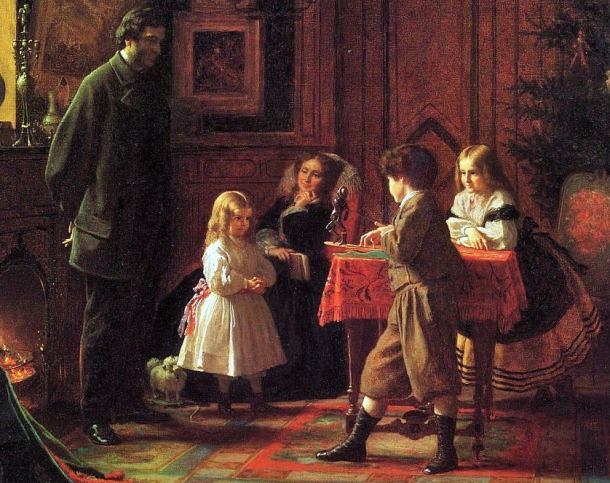Christmas in 19th Century America
http://www.historytoday.com/penne-restad/christmas-19th-century-america
Before 1850 many US citizens did not dream of Christmas at all. Penne Restad tells how and why this changed – and played its role in uniting the States in social cohesion.

The Christmas that Americans celebrate today seems like a timeless weaving of custom and feeling beyond the reach of history. Yet the familiar mix of carols, cards, presents, trees, multiplicities of Santas and holiday neuroses that have come to define December 25th in the United States is little more than a hundred years old.
Americans did not even begin to conceive of Christmas as a national holiday until the middle of the last century. Like many other such 'inventions of tradition', the creation of an American Christmas was a response to social and personal needs that arose at a particular point in history, in this case a time of sectional conflict and civil war, as well as the unsettling processes of urbanization and industrialization. The holiday's new customs and meanings helped the nation to make sense of the confusions of the era and to secure, if only for a short while each year, a soothing feeling of unity.
...
Not surprisingly, the strongest impetus for such a holiday came from those areas most profoundly affected by the various social, economic and technological revolutions of the antebellum era. Especially in the northern cities, where the intimacies of village and town culture had been most forcefully challenged by city and factory, the felt need for more explicit symbols of common purpose and shared. past grew first. A number of writers came to see holidays as a tool to meet these ends and even to forge a. national culture. New Year's Eve, the Fourth of July and, especially, Thanksgiving had their merits and partisans, but Christmas emerged as the most logical and affecting choice. By the 1850s, it had captured the Northern imagination and was making inroads in the South.
...
As early as 1832, Harriet Martineau had identified what would become one of the most familiar symbols of the American Christmas. She had 'little doubt' that the Christmas tree would 'become one of the most flourishing exotics of New England'. By the 1850s, many Americans, not just New Englanders, had fallen in love with the German custom. Some had seen Christmas trees for the first time when they had toured Germany and then recreated their experience of German Christmas celebrations for friends at home. Others viewed them first-hand in the homes of German Americans. The media introduced the custom even more widely, inspiring Americans throughout the nation to adopt the tradition as their own.
